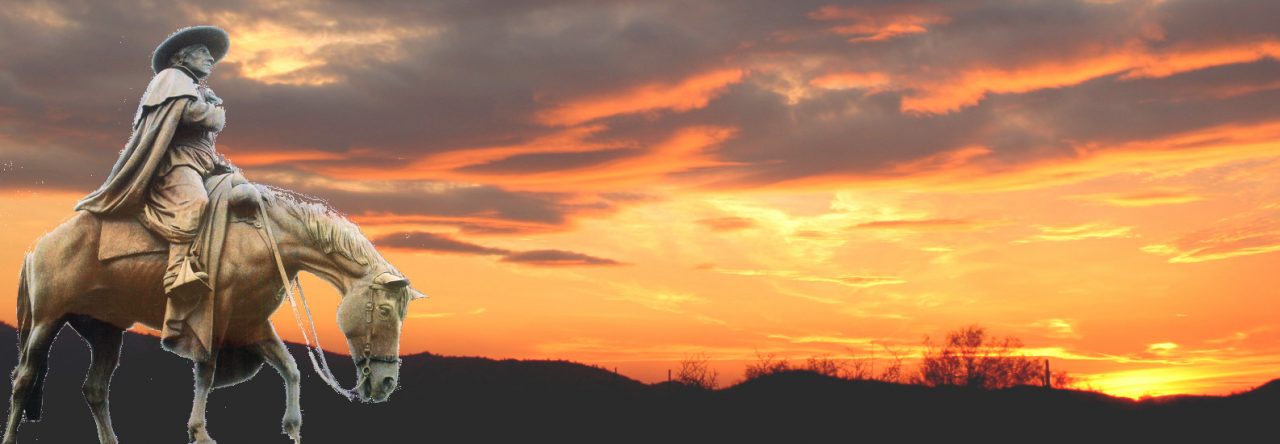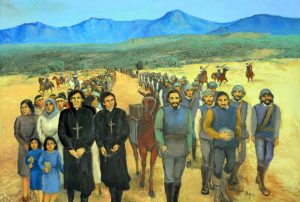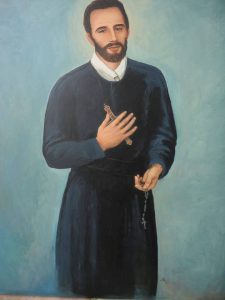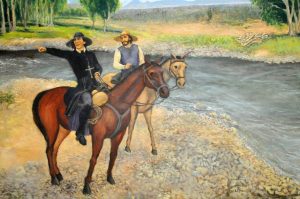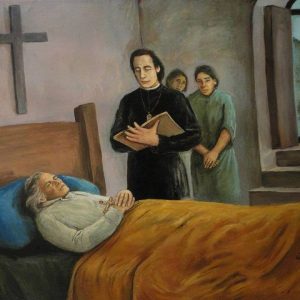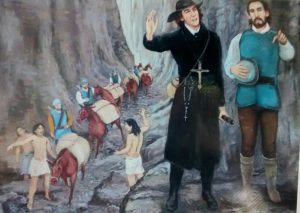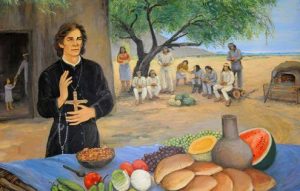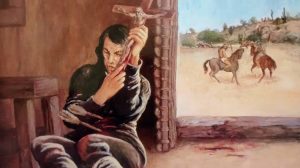As friends of padre Kino, we thank Professor Jose Cirilo Ramos Rios who produced a series of beautiful paintings covering important events of Padre Kino’s life during his ministry in Pimería. He wanted to share them on Facebook, putting forward the proposal to other local artists to share their work “On-Line”. This is what the artist refers about his proposal to share its paintings on the network with other artists on the theme of Padre Kino Kino,
“Today is the first day since I was asked by Margarita Ramirez Celaya, talented plastic artist, whom I met at an exhibition at the festival Kino in Magdalena de Kino (Sonora) in 2013, in which I present the first of my 7 works: The funeral of Father Saeta and I have the honor to invite to exhibit in this virtual gallery and make known to each other everyday work to the painter Henry Peña Monreal talented plastic artist of Hermosillo Sonora, to expose himself a ‘daily work in virtual form and then to invite another artist to do the same, explaining to do it for seven days and even then to invite another plastic artist to do the same thing ” Of this wonderful initiative, it tells us with timely attention the Facebook page “Eusebio Kino”: https://www.facebook.com/eusebio.kino.56 which invites to visit the link: http://padrekino.com/kino-legacy/missionary/.
You can also visit the interesting Facebook profile of Professor Jose Cirilo Ramos Rios at the following link:
https://www.facebook.com/josecirilo.riosramos?pnref=story
and that of his colleague Margarita Ramirez Celaya:
https://www.facebook.com/margarita.ramirezcelaya?pnref=story
We hope that such an artistic enterprise can take place even in those places where Father Kino grew up and was humanly, culturally and religiously educated .
The first of his paintings is about the funeral of Padre Saeta and represents one of the most tragic circumstances in Kino’s life for his insight in having perceived the danger and the risks that the young missionary was exposed to and for his own inability to intervene in time to save his life. More at:
http://padrekino.com/kino-legacy/missionary/
The second painting concerns St. Francis Xavier patron of the missionary who was very devoted to him and who did benefit the intercession of the Saint for his unexpected recovery.
It is customary in Sonora by devotees from father (Francisco) Kino to remember him on October 4 along with St. Francis of Assisi and St. Francis Xavier.
In 1692 Father Kino dedicated the mission of the village of Bac O’odham to St. Francis Xavier. The 325th anniversary of the first visit Kino San Xavier del Bac will be celebrated in September 2017. More information about Mission San Xavier del Bac on the site http://padrekino.com/kino-s-legacy/mission-san-xavier /
The third painting depicts Kino and Manje in Imuris. Out of more than 50,000 miles traveled on horseback, 7,500 were made alongside the Spanish officer Juan Mateo Manje that would remember it in his memoirs “The unknown Sonora and Arizona”. Information for travel on horseback and on Kino’s maps at: http://padrekino.com/kino-legacy/explorer/
The fourth painting of Prof. Jose Rios Cyril Ramos, represents “The death of Father Kino.” Next week some pilgrims will walk the Camino de Kino to Magdalena – which became a place of pilgrimage after the Missionary passed away in 1711. During the celebrations of the October 4 they pay homage to the three great Francesco in its boundaries: Francesco Saverio (as mentioned in the second painting), Frances of Assisi and Francisco Kino. For more at:
http://padrekino.com/kino-s-legacy/kino-pilgrimage/
The “Sierra de la Giganta”, the fifth painting by Prof. Jose Cirilo Ramos Rios. Kino spent the first three of his 30 years in the desert of Sonora as royal cosmographer, cartographer and surveyor of the ill-fated expedition of Atondo. – Kino led the first European expedition through the Baja. He reached the west coast in the New Year’s Eve 1685, (Bahía de Año Nuevo). – The Sierra de la Giganta is 250 miles long and is the coastal mountain range that limits the Gulf Coast. It delayed its exploration until Kino found a passage between its steep walls and through its treacherous canyon. More at: http://padrekino.com/…/exploration-baja-and-gulf-california/
“The blessing of the food” is the sixth painting of Prof. Jose Rios Cirilo Ramos. Kino introduced the native people of the Sonoran desert to many European foods. A gift for them was the Winter Wheat, (Kino Wheat) to use for food or to cultivate that transformed their lives by providing the food safety. The Kino Wheat is sown in November and December and harvested in May. More about Kino Grain at: http://padrekino.com/kino-s-legacy/kino-wheat/.
“The martyrdom of Father Saeta” by Prof. Jose Rios Cirilo Ramos – is the seventh painting in the series. In response to the brutal violence to the Tutubama people committed by the Spanish military, several inhabitants of the village moved to Caborca and killed without any reason father Francisco Saeta, a young missionary of the same religious stature of Father Kino. Padre Kinoo for several months spent himself to stop further killings of the Spanish military and his native friends. Kino then rode 1,200 miles in 30 days to Mexico City to defend the natives before the courts and the colonial authorities. Kino testified and wrote in his “Biography of Father Saeta” that “… it is evident that the treatment of the natives in Pimería was very unfair and led to mistreatment, torture and killings.” More at:
http://padrekino.com/kino-legacy/missionary/


 Italiano
Italiano Español
Español Deutsch
Deutsch